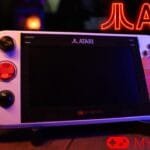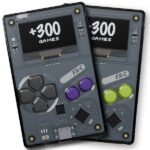A love letter to Sega, in my opinion the creator of the greatest game consoles. How I miss thee…
Dear Sega,
You really broke my heart. Why did you have to go and be like that? Just to flirt with me, for the sport of my attention? Well you got it, you got it hard-time, but what did you do with it? You hoarded it all at home in Japan and made me go begging down the local importer like something out of Dickens.
It wasn’t right. But they were good times and I will always be there for you. Always.
Sincerely,
John xx
Buckle up, buttercup, this one is going to be sad and lusty. I loved Sega (see above) and the cavalier gestures they made within the industry. A finger-in-every-pie walking contradiction of a company that promised the moon and maybe even got me more than halfway there. From time to time. For the majority of that time, they behaved absolutely like something your parents would urge you to refrain from. You had a Mega Drive, and she started well-behaved, but then she wanted a Mega CD module attached to her. Well, if you think so. Fine.
Then she wanted a 32 XXX. That’s a cartridge thing again, I thought, but she was insistent about it. Well slap it on the bill then, I suppose. That’s my Christmas gone. But then we are done then, yeah? We can just play games together? Great.

And the games were great, a lot of them. Even some of the ones that came out for those modular expenditures. Sega were firing all over the place in the early nineties; developing for themselves, publishing for others, dropping arcade napalm all over the place and generally enjoying a free-for-all attitude to business. I stress it wasn’t free to the customer. I paid, but the attitude seemed free. Like I said, they had won my heart over a barrel. Me and my Mega Drive, and her baggage, we were going to play games for years. It was going to take Sega that long to get around to making games for them all. But it was a solid down payment on the future. Sega had spread their seed and now it was a good time to settle down and carry on producing for the flock.
She had other ideas though, quite surprisingly, though it was not like there hadn’t been warning signs (see above).
Mega Drive 2 – For reals
The Sega Saturn was released in Japan on November 22nd, 1994 but didn’t begin to come to my attention until after the new year. It was before an internet, and I didn’t read smoke signals. I read Mountain Biking UK, but I should have known by history to check the horizon. There was something incoming and it was supposed to be proper next generation. The Mega Drive 2. Really truly this time, and not just a redesign of the old machine, I hoped, worrying about my fresh chequebook. I was probably going to have to start saving again or have a second fifteenth birthday.
In the end, I got a job and did some saving. There were going to be peripherals to get as well, this being Sega after all.
Boy was it all worth it, to begin with, and ongoing, although tensions in the relationship would strain before the end. I got my Saturn with Sega Rally, Virtua Fighter 2, something else that was by-the-by, and a down payment of the forthcoming NiGHTS, along with its spangly new peripheral (you gotta have one).

I was aware that by the midpoint of 1996, audiences pretty much all around the world had made Sony their bride, but I was loving my late summer romance with Sega. Yes, there were a few more things to have to buy because there really wasn’t any point in a relationship with Sega at that time if you weren’t going to buy both Virtua Cops and the twin light guns that accompanied them. But otherwise, months went by without me having to buy some module to attach. There was a rumour about a Virtua Fighter 3 Polygon Performance Pack that would make such a conversion possible, but nothing came of it.
I didn’t mind though, because I just wanted the machine alone and all of the love of its titles. Simple. Then in the summer of 1997, SNK finally got around to a PAL release of their legendary King of Fighters ‘95 conversion. Its availability would highlight two approaching things in my relationship with Sega.
Firstly, with King of Fighters, the modules were back, and secondly, I was beginning to sense that my beloved Sega was keeping things from me. Perhaps not directly, but indirectly they appeared to be failing at their once prominent position as publishers. So SNK were stand-offish to markets outside of Japan (and perhaps America), but that wasn’t anything new. But you surely couldn’t argue against Sega taking titles like Metal Slug and the ongoing King of Fighters and publishing them themselves. Sure, it was 2-D stuff, but there was a market for that on the Saturn. A lot of that was the reason people bought the console.
But other than that cartridge boosted King of Fighters ‘95, Sega wouldn’t pick up the baton and get those SNK classics across the line in any territory outside their homeland.

As 1997 went on and the market share for Sega outside Japan fell through the floor, I began to wonder if she wanted my attention at all. I was always happy to give her money for the goods, but now that no one else was offering that money, she decided to keep her goods hidden away. Was she planning a new career? Perhaps piano makers? I’m sure that they would have been world beaters, but no, she was still in the goods business of making games, so why keep them hidden away behind region locks and incomprehensible Japanese instruction manuals?
I felt pathetic, like someone who had wanted to be used, but was instead left unattended. I should have walked away from her, but instead, I took a walk down Import Alley and found a fresh way to buy her attention. A little more off-the-books and a lot more money, but I was back in her focus. And just in time, because even Saturn stalwarts Capcom had decided to exit the PAL market before the end of the year, leaving their Marvel Super Heroes conversion to be spat out in slobbering fashion by Virgin.
Dear John letter
The importing went into 1998, while my home PAL market shrivelled dry like some low-res polygon from the Saturn conversion of House of the Dead. It was a miserable time for PALs, and when Sega would get around to releasing a game it would be something like the groaning, first-generation quality misery of House of the Dead. Not Metal Slug, X-Men vs Street Fighter or Samurai Spirits. Not even titillation epic Dead or Alive got picked up for publishing in PAL, and the cup of quality to that conversion overflowed.
I was still catching the last of her import glances, but I think for the majority of UK Saturn owners, an unnecessary cold shoulder had come over the relationship. It was no wonder that a year later when Sega would go courting for attention again with the Dreamcast, so many old broken hearts would not return.
I would though. Always (see above).
Affiliate Disclosure: Some of the links in this post may be affiliate links, which means I may earn a small commission if you make a purchase through those links. This comes at no extra cost to you. Thank you for your support!
John is a former contributor with a collection of interesting retro gaming recollections.





